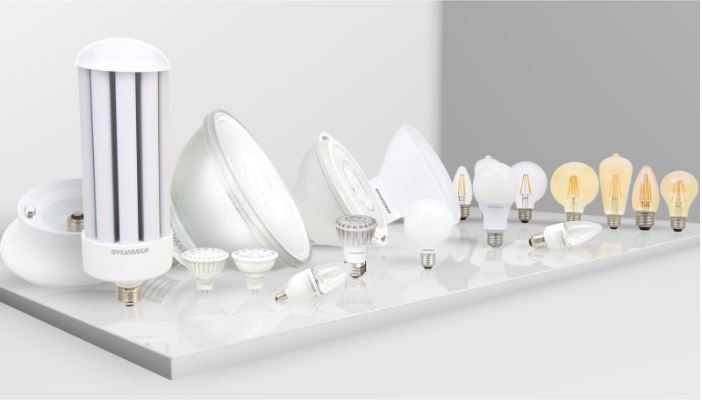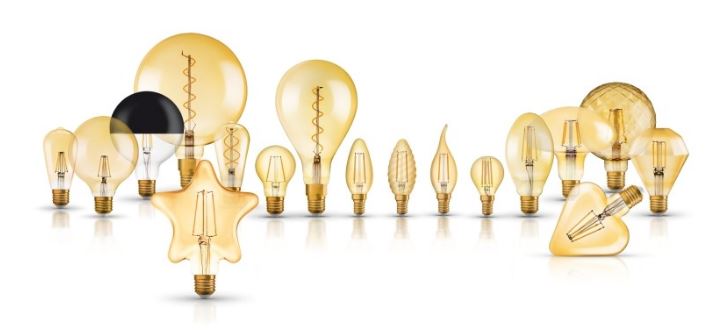Whether you're upgrading outdated incandescent systems or implementing new lighting solutions in residential commercial buildings, understanding the different light bulb sizes is crucial. Light bulbs have different distinctive characteristics that help us set them apart. The bulb sizes are identified by letters and numbers to indicate their features.
In commercial applications, several common light bulb sizes are widely used to meet various lighting needs. A type and T type bulb are often found in offices and retail spaces, offering a balance of brightness and efficiency. In high-ceiling or industrial settings, BR and PAR light bulb sizes are popular to support specific lighting needs.
In this article, we'll explain how to tell different types of light bulbs apart and the differences between their sizes, so keep reading to learn more about this topic.
Understand Light Bulb Names
Each light bulb is named using a letter and a number. The letter refers to the shape of the bulb or a special feature like the reflector type in the bulb.
The number indicates the diameter of the bulb, which is measured in millimeters or eighths of an inch. The combination of a letter and a number indicates the size of the light bulb, so you can pick a bulb of an adequate shape and size.

Light Bulb Size Chart: Quick Overview
Light Bulb Type | Common Size | Popular Application |
A Series | A15, A19, A21 | General lighting like table lamps, ceiling fixtures |
B Series | B10, B11, B12 | Decorative lighting, such as chandeliers, wall sconces for accent lighting |
C Series | C7, C9 | Christmas lights, some decorative string lights, small accent lamps |
CA Series | CA10, CA11 | Chandeliers, decorative fixtures in restaurant, foyers, often with a more elegant look |
R Series | R16, R20, R30, R40 | Recessed lighting in ceilings, track lighting, some floodlight applications for general area illumination |
MR Series | MR11, MR16 | Accent lighting in retail stores for product display |
BR Series | BR20, BR30, BR40 | Residential and commercial recessed lighting, especially for creating a wider beam of light for general room lighting |
PAR Series | PAR16, PAR20, PAR30, PAR38 | Outdoor lighting like floodlights for illuminating building exteriors, landscapes; also used in commercial settings for spotlighting in showrooms |
G Series | G4, G6.35, G9, G12 | Under-cabinet lighting in kitchens, decorative accent lighting in bathrooms, some small-scale task lighting in display cases |
T Series | T3, T4, T5, T8, T12 | Commercial and industrial lighting like office ceiling fixtures, under - counter lighting in retail, some residential garage or workshop lighting |
Full Guide to Light Bulb Sizes
In commercial lighting and the use of electrical appliances, the size of the bulb is a crucial yet often overlooked detail. Choosing bulbs of the right size not only ensures the lighting effect but also avoids problems such as installation difficulties and equipment damage caused by size mismatch.
The following is a comprehensive introduction to the relevant knowledge of bulb sizes to help you easily choose the right bulb.
A Series
A series lights are extremely popular and can be used in several applications. "A" is the abbreviation of the English word "Arbitrary", meaning common type. It's what we know as the household bulb, which you can use in a chandelier or a floor lamp.
These are the bulbs used in kitchens, closets, porches, and in ceilings. The number that comes after the letter refers to the diameter of the bulb.
| Type of Bulb | Size |
A15
| 1-7/8″ diameter |
A19
| 2-3/8″ diameter
|
A21
| 2-5/8' diameter
|
A25
| 3-1/8* diameter
|
The "B" is derived from the English word "Bullet", vividly depicting the slender shape of a light bulb with a slightly pointed head. It is commonly found in European-style chandeliers, wall lamps or table lamps, providing warm and soft yellow light and creating a retro atmosphere.
| Type of Bulb | Size |
B8
| 1″ diameter |
B10
| 1-1/4″ diameter
|
B11
| 1-3/8' diameter
|
B13
| 1-5/8* diameter
|
C SeriesC series light bulbs resemble the shape of a candle flame. These conical bulbs are shaped like a cone, adding a decorative element to your lighting fixture.C series bulbs have a bent tip, resembling the shape of a flame even more than the regular C type. These bulbs are usually used in chandeliers, wall lamps, and ornamental lamps. They also represent an excellent addition to decorative night lamps and home lighting applications.The diameter or the number that comes after the letter refers to the diameter of the bulb in one-eighth of an inch.| Type of Bulb | Size |
C10
| 1-1/4″ diameter |
C7
| 7/8″ diameter
|
C9
| 1-1/8' diameter
|
C15
| 1-7/8* diameter
|
It is often used in decorative lighting such as chandeliers, candlestick lamps, and vintage wall lamps, and is especially suitable for lighting arrangements in European classical, pastoral or festive atmospheres.| Type of Bulb | Size |
CA5
| 1-1/4″ diameter |
CA7
| 7/8″ diameter
|
CA8
| 1-1/8' diameter
|
CA10
| 1-7/8* diameter |
CA11
| 1-3/8″ diameter
|
| Type of Bulb | Size |
R12
| 1-1/2″ diameter |
R14
| 1-3/4″ diameter
|
R16
| 2* diameter |
R20
| 2-1/2″ diameter
|

MR Series
MR bulbs or mirrored reflector bulbs are small in size, and the interior is faceted and covered in reflective material. This bulb concentrates the light beam to be displayed in a narrow and focused spot or a wide beam of light, depending on the design.
The MR bulbs are usually used in landscape lighting because they can replace halogen lights. They also come in various colors for decoration, so they can be used as desk lights, recessed lighting, and display lights.
Most MR bulbs operate in low-voltage wiring systems, so they work for outdoor applications like path lights, driveway lights, gazebo lights, and porch lights. They also usually have a waterproof casing to protect these bulbs from weather conditions.
| Type of Bulb | Size |
MR12
| 1-1/2″ diameter |
MR14
| 1-3/4″ diameter |
MR16
| 2* diameter |
MR20
| 2-1/2″ diameter
|
BR Series
"BR" is the abbreviation of "Bulged Reflector". Its feature is the reflective surface of the lamp body which is designed in a convex shape. Compared with ordinary R-type bulbs, BR type has a larger light diffusion angle, a wider illumination range and softer light. BR type bulbs are often used in places such as household downlights and ceiling lights where uniform lighting is required.
| Type of Bulb | Size |
BR25
| 3-1/8″ diameter |
BR30
| 3-3/4″ diameter |
BR38
| 4-3/4* diameter |
BR40
| 5″ diameter
|
PAR Series
PAR series bulbs are named after the Parabolic Aluminized Reflector. This is different from the U-shaped reflector that is used in incandescent bulbs.
The parabolic aluminized reflector is used to maximize brightness and direct the light to create a narrow or wide beam. The bulb has a shorter body and is usually installed by being flushed to the ceiling or other fixtures to reduce glare.
PAR bulbs are usually used for emergency outdoor lighting or spot lighting because the light from these bulbs doesn't fade as much as other types of bulbs. They also operate using low-voltage wiring, so they can be used in landscape lighting.
| Type of Bulb | Size |
PAR16
| 2″ diameter |
PAR20
| 2-1/2″ diameter |
PAR30
| 3-3/4* diameter |
PAR36
| 4-1/2″ diameter
|
G Series
G series bulbs are commonly used in home applications. They're round-shaped and come in various sizes to suit various purposes. "G" stands for "Pin". According to the differences in the number and spacing of the pins, it can be further classified into multiple types.
You can use G type bulbs as kitchen lights, foyer lights, or in chandeliers and ornamental fixtures. They can also be used as vanity lights or have a gold tint for a decorative effect. Although they come in different sizes, the most common bulbs are the bigger ones.
| Type of Bulb | Size |
G11
| 1-3/8″ diameter |
G14
| 1-3/4″ diameter |
G16
| 2* diameter |
G25
| 3-9/64″ diameter
|

T SeriesT series or tubular bulbs can be used in wall sconces, garage lights, in pendants, and as basement lighting. T-shaped bulbs were mostly fluorescent tubes in the early days, but now they are mainly LED bulbs. These lights come in various sizes, so you can pick the right one for your application.
It is suitable for places that require linear light sources, such as cabinet lighting, bathroom mirror front lights, office lamps or industrial lighting.
| Type of Bulb | Size |
T7
| 7/8″ diameter |
T8
| 1″ diameter |
T10
| 1-1/4″ diameter |
T14
| 1-3/8″ diameter
|
How to Choose Right Light Bulb Size for Your Lighting Need
Choosing the appropriate bulb size for commercial lighting requires comprehensive consideration. First of all, the physical size of the bulb must be compatible with that of the lamp. Different types of lamps, such as downlights, panel lights, chandeliers or track spotlights, have specific requirements for the length, diameter and shape of the bulbs.
For instance, recessed downlights typically require smaller-sized LED bulbs, while large chandeliers may be compatible with standard A19 or A21 bulbs. If the bulb is too large, it may not be installed or affect the heat dissipation of the lamp. If it is too small, it may lead to uneven distribution of light.
Also, the specification of the bulb base must match the interface of the lamp. Common types of bulb base in business environments include E26 and GU10. Choosing the wrong model can result in installation failure. In addition, some special lamps may require bulbs of specific sizes.
Finally, the size of the bulb also affects the luminous efficiency and heat dissipation. High-power LED bulbs are usually larger in size to enhance their heat dissipation capacity. Compact bulbs are suitable for space-constrained situations, but they may sacrifice some brightness or lifespan. Therefore, while meeting the lighting requirements, it is necessary to ensure that the selected size can fit the lamps and optimize their performance.
Conclusion
Light bulbs come in all shapes and sizes, and their shapes and sizes are indicated by a letter and a number. The letter indicates the shape of the bulb and affects how it can be used. Light bulb sizes don’t have to be confusing. Once you crack the code, deciding lighting solutions becomes way easier and more satisfying.
The number refers to the diameter of the bulb in eighths of an inch. Some types of light bulbs are interchangeable, but in most cases, every specific light bulb is suitable for a certain purpose. In a market moving towards energy efficiency and sustainability, getting bulb sizing right is a key operational advantage.



